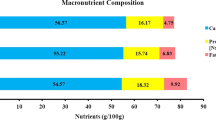Abstract
Sorghum, pearl millet, and finger millet flours (60% of each) were blended with toasted mung bean flour (30%) and nonfat dry milk (10%) and extruded (Brabender single screw) to make precooked, ready-to-eat, weaning foods. The extruded foods had high cold paste viscosity, but their cooked paste viscosity was lower than that of the respective blends. Chemical scores of the extruded foods were 78 for sorghum, 80 for pearl millet, and 96 for finger millet. Protein digstibility corrected amino acid scores (PD-CAS) were similar for pearl millet (68%) and finger millet (69%); PD-CAS for sorghum was 57%. Total dietary fiber content of the foods ranged from 7.6 to 10.1%, with the soluble dietary fiber content of the foods being about 10% higher than that of the corresponding blends. Extrusion enhanced the in vitro protein digestibility of foods, but no marked difference occurred in the in vitro carbohydrate digestibility among the unprocessed blends and the extruded foods. The net protein ratio, protein efficiency ratio, and biological values were higher for the finger millet food than for the pearl millet food, probably because of the higher lysine content of the finger millet protein.
Similar content being viewed by others
References
Hulse JH, Laing EM, Pearson OE (1980) Sorghum and the millets: Their composition and nutritive value. New York: Academic Press.
Malleshi NG (1993) Processing of coarse cereals for food and industrial uses. In: Food Technology Highlights Souvenir. 3rd International Food Convention. Mysore: Assoc. of Food Scientists and Technologists, p. 58.
Rooney LW, McDonough CM (1987) Food quality and consumer acceptance of pearl millet. In: Witcombe JR, Beckerman SR (eds), Proc. of International Pearl Millet Workshop. Pantancheru: International Crops Research Institute for Semi-Arid Tropics, pp. 43–61.
Malleshi NG, Desikachar HSR, Venkat Rao S (1986) Protein quality evaluation of weaning food based on malted ragi and green gram. Plant Foods Hum Nutr 36: 223–230.
Dutra-de-Oliveria JE (1991) Malnutrition in developing countries: The challenges to and the responsibility of the experts. Proc Nutr Soc India 37: 29–38.
Dale CJ, Young TW, Makinde A (1989) Extruded sorghum as a brewing raw material. J Inst Brew 95: 157–164.
Youssef AMM, Moharram YG, Moustaffa EK, Bolling H, Baya AE, Harmuth AE (1990) New extruded products from sorghum. Food Chem 37: 189–199.
Almeida-Dominguez HD, Gomez MH, Serna-saldivar SO, Waniska RD, Rooney LW, Lusas EW (1993) Extrusion cooking of pearl millet for production of millet-cowpea weaning foods. Cereal Chem 70: 214–219.
Abdelrahman A, Hoseney RC, Varriano-Marston E (1983) Milling process to produce low-fat grits from pearl millet. Cereal Chem 60: 189–191.
Chinnaswamy R, Hanna MA, Zobel HF (1989) Microstructural, physicochemical, and macromolecular changes in extrusion-cooked and retrograded corn starch. Cereal Foods World 34: 415–422.
AACC (1991) Approved Methods. St. Paul, MN: American Association of Cereal Chemists.
Brandtszaeg B, Malleshi NG, Svanberg U, Desikachar HSR, Mellander O (1981) Dietary bulk as a limiting factor for nutrient intake with special reference to the feeding of pre-school children, III: Studies on malted flours from ragi, sorghum and green gram. J Trop Pediatrics 27: 184–189.
Mouliswar P, Kurien S, Daniel VA, Malleshi NG, Venkat Rao S (1993) In vitro digestibility of protein and starch of energy food and its bulk reduction. J Food Sci Technol 30: 36–39.
Liu TY, Chang YH (1971) Hydrolysis of protein withp-toluenesulfonic acid. J Biol Chem 246: 2842–2848.
Spackman DH, Stein WH, Moore S (1958) Automatic recording apparatus for use in the chromatography of amino acids. Analytical Chemist 30: 1190–1206.
ISI (1969) Specifications for processed cereal weaning foods. No. 1656. New Delhi: Indian Standards Institution.
Pellet PL, Young VR (1980) Some rat and human bioassay procedures. In: Nutritional Evaluation of Protein Foods. Tokyo: United Nations University, pp. 103–120.
Huber GR (1991) Carbohydrates in extrusion processing. Food Tech 45: 160–168.
Ljungquist BG, Mellander O, Svanberg U (1981) Dietary bulk as a limiting factor for nutrient intake in pre-school children, I: A problem description. J Trop Pediatrics 27: 68–73.
Malleshi NG, Desikachar HSR (1980) Reducing the paste viscosity (dietary bulk) of roller dried weaning foods using malt flour or fungal amylase. J Food Sci Technol 25: 1–3.
Coulter LA, Lorenz K (1991) Extruded corn grits-quinoa blends, II: Physical characteristics of extruded products. J Food Proc Preser 15: 243–259.
FAO (1991) Protein quality evaluation. FAO Food and Nutrition Paper 51. Report of the Joint FAO/WHO Expert Consultation, Bethesda, MD, USA, 4–8 December 1989.
USDA (1976) Composition of foods: dairy and egg products. Agriculture Handbook 8-1. Washington, US Government Printing Office.
USDA (1986) Composition of foods: legumes and legume products. Agriculture Handbook 8-16. Washington, DC: US Government Printing Office.
Pattabiraman, TN (1986) Trypsin/chymotrypsin inhibitors from the millets. In: Nutritional and toxicological significance of enzyme inhibitors in foods. Advances in Experimental Medicine and Biology 199: 439–448.
Fapojuwo OO, Maga JA, Jansen GR (1987) Effect of extrusion cooking on in vitro protein digestibility of sorghum. J Food Sci 52: 218–219.
Dahlin KM, Lorenz KJ (1993) Carbohydrate digestibility of laboratory-extruded cereal grains. Cereal Chem 70: 329–333.
WHO (1985) Energy and protein requirements. Technical Report Series 724. Geneva: FAO/WHO/UNU Expert Consultation, World Health Organization.
Ensminger AH, Ensminger ME, Konlande JE, Robson JRK (1994) Foods & Nutrition Encyclopedia, 2nd ed., vol. 2, p 1872. Boca Raton, FL: CRC Press.
Klopfenstein CF, Hoseney RC, Leipold HW (1985) Nutritional quality of pearl millet and sorghum grain diets and a pearl millet weanling food. Nutr Rep Intl 31: 287–297.
Vaidehi MP, Varalakshmi R (1992) Protein quality of extrusion cooked foods of blended wheat, sorghum, horsegram, and sunflower seed cake. Beverage Food World 19: 22–24.
Author information
Authors and Affiliations
Additional information
Contribution No. 95-253-J of the Kansas Agricultural Experiment Station.
Rights and permissions
About this article
Cite this article
Malleshi, N.G., Hadimani, N.A., Chinnaswamy, R. et al. Physical and nutritional qualities of extruded weaning foods containing sorghum, pearl millet, or finger millet blended with mung beans and nonfat dried milk. Plant Food Hum Nutr 49, 181–189 (1996). https://doi.org/10.1007/BF01093214
Received:
Accepted:
Issue Date:
DOI: https://doi.org/10.1007/BF01093214




